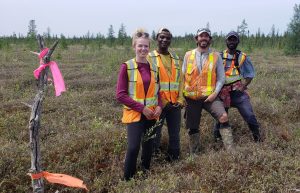Scientists will test restoration techniques at a large peatland site in southeastern Manitoba as part of a Brandon University (BU) project supported by the Natural Sciences and Engineering Research Council of Canada (NSERC).
The work will build upon and inform how existing Canadian-based restoration techniques could be adapted to the drier Manitoba climate.
The project, being led by Dr. Peter Whittington, of BU’s Department of Geography and Environment, will receive an Alliance Grant, worth $250,000 over five years, from NSERC, the Canadian Sphagnum Peat Moss Association (CSPMA) and its members. The project will allow the researchers to learn more about restoring peatlands, which play a valuable role in storing carbon in addition to having important hydrological and biogeochemical functions in the landscape and a biodiversity of their own.

“Peatlands store more carbon than all of the world’s forests combined, despite covering only three per cent of the Earth’s surface,” Dr. Whittington said. “A very small proportion of these sites are used to produce horticultural peat, or the ‘peat moss’ that commercial growers use to grow vegetables and flowers, but after the peat is extracted, a site needs to be restored so it can accumulate carbon again.”
Peatlands are normally classified as bogs or fens. Most peatlands in Canada are restored as bogs, which get their water only from rain. Unlike bogs, fens get water from streams and groundwater as well as rain. Dr. Whittington will work with Dr. Maria Strack of the University of Waterloo to see what approaches work best to create favourable conditions to promote the restoration of a peat extraction site to a fen. The NSERC Alliance Grant requires partner organizations so that the knowledge generated from the research can be mobilized quickly by the partner, in this case, the CSPMA and its members, especially Sun Gro Horticulture where the restoration will be completed.
“We will try different approaches to see how effective they are at maintaining water on the site and storing carbon,” said Dr. Whittington, who was recently elected as President of the Canadian Geophysical Union — Hydrology Section. “Because connectivity is so important for a fen’s hydrological functions, we plan to make use of the surrounding landscape to create a gentle slope between the natural ecosystem and the restored fen to encourage the flow of water and nutrients to the restoration site.”
“This is a major project that has beneficial environmental and agricultural applications,” said Dr. Bernadette Ardelli, Dean of Science at BU. “Dr. Whittington has developed a leading research program in the field of peatland hydrology that is providing valuable experience for our students and will also be very influential in future restoration efforts across Canada. I’m excited to see his work take another step forward with this collaborative research.”
Contact
- Brandon University
- communications@brandonu.ca
To receive any BU publication in an alternate format please contact Communications@BrandonU.ca
About BU
Success is built at Brandon University. Our growing, progressive campus welcomes a diverse and inclusive community that combines proud tradition with shared ambition. Through our excellence in teaching, research, and scholarship, we educate students to make a meaningful difference as engaged citizens and leaders. Join us at BrandonU.ca.